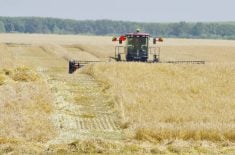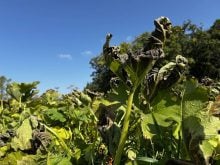Previous wet conditions and rain over the weekend have slowed harvest progress. Winter wheat and fall rye are emerging with good establishment. Fall field work including fertilizer applications, tillage, soil testing, and drainage is on-going.
Southwest Region
Seasonal to above normal temperatures during the week allowed for good harvest progress to be made. A weekend storm stalled harvest progress and brought 10 to 75 mm of rain to some areas. There were reports of hail damage.
Read Also

Still hard to predict precise fertilizer payback
Despite decades of advances, international research finds no clear answer for where and when adding nutrient will fail to boost growth.
Spring cereal harvest is approaching completion with only isolated fields remaining.
Overall 70 to 80 per cent of canola harvest is complete. The majority of canola harvested this week was straight cut. Canola yields and quality are good.
The majority of soybeans have reached the R8 stage of development but due to wet conditions, very few producers have started harvesting soybeans. For the soybeans that have been harvested yields are average to below average.
Flax harvest has started, but no yield reports to date.
Winter wheat and fall rye seeding is complete. Frequent rains and showers have resulted in excellent emergence and early season growth with most fields now in to the 2 to 3 leaf stage.
Several producers were able to put up corn silage over the past week and yields look to be average to above average with good quality.
Grain corn and sunflowers continue to mature. No harvest reports yet.
Several producers are moving cattle to fall pastures and some are selling calves. Overall feed outlook is good. Producers are cleaning up sloughs and marshland that have not been cut in years, increasing the amount of feed.
Northwest Region
Good harvest progress was made throughout the week and into the weekend. Some field work followed on fields that were harvested. Rain started late Sunday night and continued into Monday, bringing all harvest operations and field work to a halt. Moderate to high day time temperatures throughout the week and weekend helped crops dry down, while night time temperatures dipped down most nights, with a hard frost early Friday morning.
Progress on canola harvest moved along steadily over the past week with Roblin reported as nearly complete, the Swan Valley region approximately 85 per cent complete, and yields for the entire region ranging from 50 to 60 bu/ac. Spring wheat harvest is near completion with 90 to 100 per cent of the crop harvested for the region. Spring wheat yields of 75 to 80 bu/acre around Roblin and 60 to 90bu/acre around Swan River have been reported. Harvest of barley and oats is generally complete with reports of oats yielding 150 bu/acre and barley yielding 100 bu/acre in the Roblin area. Soybean harvest has started in the Swan Valley region with approximately 15 per cent complete. Reported yields so far range from 35 to 50 bu/ac. Flax remains standing in the Roblin area. Peas are harvested with yields range from 60 to 75 bu/acre in the Roblin and Swan River areas. Volunteers and weeds continue to actively grow in fields that are harvested.
Corn silage harvest continues with reported yields ranging from 14 to 18.5 tons/ac. More bear damage has been noted in corn silage fields this year. Light frosts have producers inquiring about nitrates. Cattle are being hauled home, or to fall pastures, as summer pasture growth is slowing down.
Central Region
Harvest progressed slowly this past week, due to the previous week’s rains. Producers were back in the fields by Thursday/Friday, and strong winds allowed for long hours of combining until showers started on Sunday afternoon. Harvest and fieldwork are currently at a standstill. Harvest is estimated at 70 to 90 per cent complete. A very light frost occurred on Friday in the northwest part of the region, with minimal impact on crops or forages.
Cereal, canola, pea and, flax yields and quality are very good this year; harvest of those crops is generally complete. Yields are reported as; hard red spring wheat 55 to 100 bu/acre, barley 75 to 120 bu/acre, oat 110 to 180 bu/acre, canola 40 to 65 bu/acre, field pea 50 to 90 bu/acre, flax 27 to 40 bu/acre.
Soybean harvest continues, ranging from 60 to 70 per cent complete for the region; and is more advanced in the eastern part of the region. Early yield reports are in the 17 to 50 bu/acre range; average yield is expected to be 30 to 35 bu/acre.
Edible bean harvest is 70 to 75 per cent complete. Yields are average to slightly above average. Early yield reports are 1800 to 2000 lb/acre for pintos, and 2000+ lb/acre for cranberries. Higher yields have been reported. Some quality issues reported where beans were lying in swath during rains, but quality is generally good.
Corn silage harvest has begun. Grain corn was ripening prematurely due to dry conditions; harvest is likely two weeks away.
The most advanced sunflower fields have been desiccated; harvest will start when conditions allow. High numbers of blackbirds are reported in some corn and sunflower fields.
Potato harvest is ongoing.
Winter cereals are germinating and emerging.
Some fields are being assessed for post harvest weed control, as rains have improved weed regrowth. There have been some inquiries regarding testing for suspected herbicide resistant weeds.
Post harvest harrowing and cultivating operations continue; rains have improved field conditions significantly. Scraping for surface drain maintenance is underway; good progress has been made.
Soil sampling for nutrient availability continues, and fertilizing has begun.
Second cut hay is complete, yields are below average. Wild hay harvest continues. Livestock water supply is 85 per cent adequate. More rainfall is needed to replenish dugouts. Dugouts are low on many pastures as the water table has dropped significantly. Some producers have had to travel to be able to secure straw supplies.
Eastern Region
Harvest resumed on Thursday/Friday, and continued until rainfall began on Sunday afternoon. Total rainfall accumulations for last week ranged from 5 to 70 mm with southern districts receiving the highest accumulations. During the latter half of the week, daytime temperatures were normal to above normal under sunny skies with sometimes windy conditions.
Average soil moisture conditions on cropland were rated as 100 per cent adequate across the region. Soil moisture conditions on hay and pasture land were rated at 80 per cent adequate and 20 per cent short with the driest soil conditions occurring in southern districts.
Canola harvest is nearing completion with approximately 95 per cent of the crop harvested. Yields are being reported in the 45 to 55 bu/ac range. Soybeans are in the R8 growth stage and dried down, approximately 25 per cent of soybeans in the region have been harvested. Yield reports are ranging from 20 to 40 bushels per acre.
Most sunflower acres have been desiccated and are drying down. Corn is at R6 and drying down.
Some pasture and hay fields that received hog manure are demonstrating good regrowth which some producers are grazing. Corn silage being harvested with generally good yields but some producers had disappointing yields as the cobs where on the small size. Dugouts are about half full with this past week’s rainfall. Livestock producers are starting to feed livestock on pasture. Livestock winter feed supplies were rated as 20 per cent surplus and 80 per cent adequate for hay and straw and adequate for greenfeed and feed grains. Pasture conditions were rated as 20 per cent good, 30 per cent fair, 40 per cent poor and 10 per cent very poor. The availability of livestock water was rated as adequate.
Interlake Region
Intermittent rains and cool, wet conditions continue to stall harvest; the weather allowed for one day of combining in the last seven. There have been no killing frosts reported by any of the weather stations so far this fall.
In the south Interlake, canola, cereal and peas harvest is complete with excellent yields. Approximately 60 to 70 per cent of the soybeans are harvested with yields in the 30 to 35 bu/acre range. Sunflowers are dessicated and corn is mature but needs to dry down before harvest.
Approximately 40 per cent of fall field work is complete in the south Interlake. The majority of cereal acres have been tilled.
In the north Interlake, approximately 40 per cent of the soybeans, 50 per cent of the canola, and 10 per cent of the alfalfa seed have been harvested. Some late dessication of alfalfa seed crops is still occurring.
Heavy harrowing and deep tillage are occurring throughout the north Interlake.
Phosphorus fertilization is occurring throughout the region on fields that are intended for soybeans in 2018. Fertilization of hayfields is starting.
Soil moisture conditions across the region on cropland, hay and pasture are rated as 100 per cent adequate.
Grass growth has slowed with cooler temperatures and shorter day lengths, and cattle are being moved off summer pastures or supplemental feeding occurring. Most haying is complete.
Pastures are rated fair to good. Dugouts are 10 to 50 per cent full and water quality varies from poor to good.














